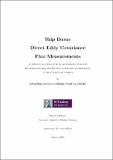| dc.contributor.advisor | Ward, Brian | |
| dc.contributor.author | Landwehr, Sebastian Johannes Heinz-Josef | |
| dc.date.accessioned | 2015-03-18T13:51:20Z | |
| dc.date.available | 2015-03-18T13:51:20Z | |
| dc.date.issued | 2015-01-28 | |
| dc.identifier.uri | http://hdl.handle.net/10379/4912 | |
| dc.description.abstract | Ship borne direct eddy covariance flux measurements of momentum, heat (latent and sensible), and the trace gas CO2, were conducted during three open ocean experiments. The methods for data analysis and interpretation were adapted from the literature, and
reviewed carefully. Two major sources of measurement errors were studied in detail: the air-flow distortion by the platform superstructure and the cross-sensitivity of the CO2 signal to water vapour. For both topics a revision of the treatment, as suggested in the literature, was found necessary.
Air-flow distortion can lead to a tilt of the wind vector as well as acceleration of the wind speed. Eddy covariance measurements are additionally affected by the platform motion. The classic approach is to first correct for the platform motion and thereafter rotate the
wind vector into the mean flow. For moving ships, this causes an over-estimation of the tilt, because the flow distortion-induced vertical velocity is proportional to the relative wind speed. The overestimated tilt leads to biased flux estimates.
This may explain the common observation that flux estimates from moving ships
have lower quality than measurements taken on station. An alternative method is presented here, where the flow distortion-induced tilt is estimated from the wind speed measurements and applied after correcting for the platform motion, but before removing the ship's mean velocity. This significantly reduced the flow distortion error in the direct flux measurements.
With respect to CO2, the flux measurements are affected by cross-sensitivities to water vapour, resulting in order-of-magnitude biases. Well established cause are (i) band-broadening and spectral overlap, and (ii) air density fluctuations. Both can be corrected. A
further bias related to humidity fluctuations has recently been observed with the widely used CO2/H2O open-path sensors produced by LICOR, attributed to sea salt build-up and
water films on the sensor optics. Two different approaches have been used: Miller et al. (2010) employed a membrane drier to physically eliminate 97% of the water vapour fluctuations in the sample air before it entered a closed-path gas analyser.
Prytherch et al. (2010a) formulated the PKT (Peter K. Taylor) post-processing correction. Here these methods are compared using four closed-path analysers, two of which were positioned down-stream of membrane dryers. The CO2 fluxes from the dried analysers matched each other and were in general agreement with common parameterisations. The measurements from the un-dried sensors agreed only when the humidity flux was low and exhibited order-of magnitude biases otherwise. The PKT correction did not remove the bias. The results demonstrate the validity of measuring CO2 fluxes
at pre-dried air and disprove the PKT correction. | en_US |
| dc.rights | Attribution-NonCommercial-NoDerivs 3.0 Ireland | |
| dc.rights.uri | https://creativecommons.org/licenses/by-nc-nd/3.0/ie/ | |
| dc.subject | Eddy Covariance | en_US |
| dc.subject | Air-sea interaction | en_US |
| dc.subject | Flux measurements | en_US |
| dc.subject | Air-flow distortion | en_US |
| dc.subject | PKT | en_US |
| dc.subject | Peter K. Taylor correction | en_US |
| dc.subject | humidity bias | en_US |
| dc.subject | CO2 | en_US |
| dc.subject | LICOR | en_US |
| dc.subject | School of Physics | en_US |
| dc.subject | Humidity Bias | en_US |
| dc.subject | Humidity Bias | en_US |
| dc.subject | Co2 | en_US |
| dc.subject | Momentum Flux | en_US |
| dc.subject | Buoy | en_US |
| dc.subject | Ship | en_US |
| dc.subject | Motion Sensitivity | en_US |
| dc.subject | Gas Analyser | en_US |
| dc.title | Ship Borne Direct Eddy Covariance Flux Measurements | en_US |
| dc.type | Thesis | en_US |
| dc.contributor.funder | Science Foundation Ireland | en_US |
| dc.local.note | This thesis deals with ship borne measurement of air-sea fluxes of carbon dioxide, heat, moisture and momentum, by observing turbulent motions near the sea surface. These fluxes are important for weather prediction and climate models but direct measurements at sea are complicated and need large corrections. | en_US |
| dc.local.final | Yes | en_US |
| nui.item.downloads | 1858 | |


